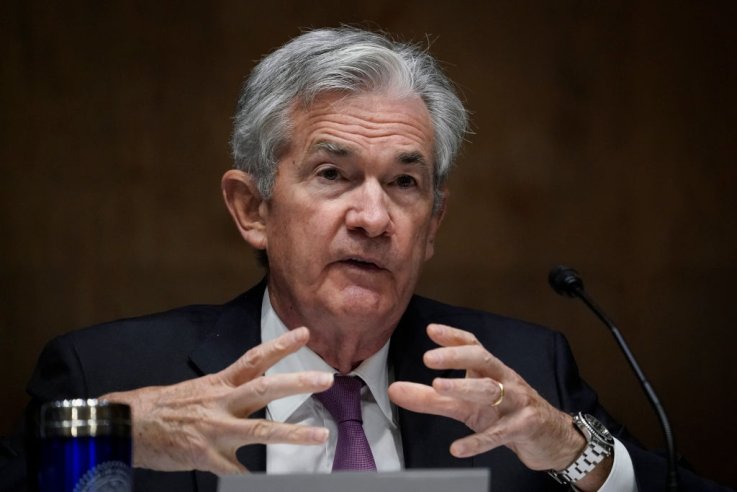Indicators Show Investors Buying and Holding Bitcoin
Bitcoin has stabilized above $55,000 while maintaining a market cap of $1 trillion for 27 of the last 30 days, and may be about to rally, an analyst believes.
Investors appear to be buying and holding Bitcoin in anticipation of future price gains.
Lennard Neo, a certified financial analyst and head of research at Stack Funds in Singapore, said the number of Bitcoins transferred from exchanges hit a one-year high since the "flash crash" in 2020, when the cryptocurrency's price dropped about $1,500 in an hour.

"The spikes in Bitcoin outflows from exchanges typically coincides with upside price action in the following days, as investors continue to accumulate during the dips of this bullish market cycle," he said in a research report.
"We expect a similar outcome to unfold this time as well. Bitcoin exchange outflows have currently spiked above the 100,000 level, and during 2020, there were only five occurrences," the report said. "However, since the start of 2021, this has happened four times in the short span of a few months. The evidence suggests that investors are not only buying the dip, but also accumulating Bitcoins at a faster rate."
Neo said the Bitcoin network continues to expand and mainstream adoption continues to grow, creating increased demand for the cryptocurrency and likely driving prices higher.
"For those critics who still think that Bitcoin has no intrinsic value and will not emerge into an asset class, we sincerely urge them to think out of the box," he said.
Major companies continue to invest in Bitcoin, underscoring the cryptocurrency's growing mainstream acceptance. Electric carmaker Tesla and software developer Microstrategy have invested in Bitcoin, and top Wall Street firms now offer exchange-traded funds to their clients.
The New York Digital Investment Group (NYDIG), a division of Stone Ridge Holdings Group and a provider of Bitcoin investment tools, on Thursday said it had raised $100 million in from property and casualty insurers Starr Insurance, Liberty Mutual Insurance. New York Life and MassMutual, providers of life insurance and annuities, have also invested in NYDIG.
Ross Stevens, CEO of Stone Ridge and Executive Chairman of NYDIG, said his organization will continue to expand its offerings in Bitcoin-denominated products.
"Fiat (money) depreciation causes inflation in fiat premiums, while collapsing the purchasing power of claims," he said in a statement. "We see a brighter Bitcoin-powered future for the billions who depend on the insurance industry every year."
In mid-day trading Thursday, Bitcoin changed hands at $57,702.90. The cryptocurrency is up 98.7% for the year. The record high is $61,712, CoinDesk reported.
Market Pulse
Vaccinations and continued low interest rates are boosting long-term prospects for an economic recovery.
About 33% of the U.S. population has received at least the first dose of the COVID-19 vaccine, and that could increase to 75% in a few months if the current vaccination pace is maintained.

The Federal Reserve, the nation's central bank, plans to keep interest rates low through 2023. That will hold down mortgage rates and the cost of consumer credit, encouraging spending.
Through March, there were 8.4 million fewer jobs than in February 2020, the month before the pandemic hit and governors ordered a shutdown as part of the effort to limit the spread of COVID-19.
"The economic recovery remains uneven and far from complete, and the path ahead remains uncertain," Jerome Powell, chairman of the Federal Reserve, said at a press conference after this week's Federal Open Market Committee meeting.
"Monetary policy will continue to deliver powerful support to the economy until the recovery is complete."
The Fed sees no immediate threat of inflation. It has averaged 1.5% in the last 10 years, below the central bank's target of 2%.
Minutes of the meeting show that Fed governors believe President Joe Biden's $1.9 trillion COVID-19 relief package, signed into law March 11, will boost prospects for small businesses and consumer spending, which represents about two-thirds of the U.S. economy.
However, the Fed will continue monthly bond purchases as part of the effort to boost the economy and there will be no immediate miracles.
Jobless claims rose to 744,000 for the week ended April 3, exceeding the 728,000 filed a week earlier, the Labor Department reported Thursday.
Analysts surveyed by Dow Jones expected 694,000 new claims to be filed.
"The nation's economy isn't yet fully open nor is the pandemic vanquished," Mark Hamrick, Senior Economic Analyst at Bankrate.com said in a statement. "While it is disappointing and somewhat surprising to see the number of seasonally adjusted new unemployment claims rise for a second straight week, it is understandable that some employers continue to struggle."
In March, non-farm payrolls grew by 916,000 and the unemployment rate dropped to 6%. It peaked a year ago this month at 14.7%.
"We've come a long way, but healing of the economy and job market remain works in progress. Better times are ahead," Hamrick said.

